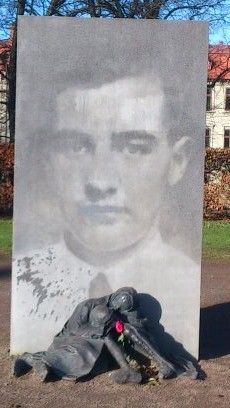Raoul Wallenberg

Raoul Wallenberg was born in Lidingö outside Stockholm, August 4, 1912.
Raoul soon became fatherless and grew up with his mother, who was widely supported by Raoul's grandfather.
Grandfather Gustav was the son of André Oscar Wallenberg, who founded Stockholms Enskilda Bank, SEB,
which today is one of Sweden's largest banks, and it is still run by the Wallenberg family.
Gustav had big plans for Raoul and made sure he got an education abroad.
It was projected that Raoul would be something within the banking area, but Raoul did not want to follow these plans,
and he studied rather to become an architect at the University of Michigan, 1931-35. After graduation, he was sent
out on educational trips to among others South Africa and Haifa, where he worked in the banking and business world.
In Haifa, Raoul came in contact with Jews, who had fled persecution in Nazi Germany. Raoul early showed great empathy for the Jews' situation.
After short assignments for Stockholms Enskilda Bank, Raoul was in 1941 employed as director at Central European Trading Company Limited abroad
and was doing the export and import of food between Sweden and Hungary. From 1942, Raoul was a frequent traveler to Hungary.
The situation of the Jews in Hungary became increasingly critical.
Until March 1944, they had been relatively spared compared with Jews in German-occupied territories in Europe.
When the Germans attacked and took control of Hungary in March 1944, the notorious Adolf Eichmann was given the mission
to solve the so-called Jewish question in Hungary. In view of the situation getting more and more serious, the U.S. government organization
“War Refugee Board”, which had the task to save Jews in Europe, required help with a person from neutral Sweden,
who could organize a rescue work in Hungary. Wallenberg was chosen for the mission, and he became included as a diplomat
at the Swedish embassy. The rescue work was funded by the “War Refugee Board”, and the mission was initially to observe and report,
but quickly developed to mobilize and lead the work of the so-called protective passports or “Schutzpass”. The Hungarian authorities had approved
that the passports worked as certificates for foreign citizens, and thus Jewish people could, through these “Schutzpass”,
be excluded from the Jewish law. After negotiations, the Swedish delegation was entitled to issue 4500 passports. It is unclear,
how many people Wallenberg and the others at the Swedish Embassy managed to save, but it is certain that it was a question of thousands of Jews.
In the winter of 1944, the Hungarian Nazis took control of the country,
and it became increasingly difficult and risky with the rescue works. During the winter of 1944-45, districts of Budapest
were liberated by the Soviet Union. In January 1945 Raoul Wallenberg lived at various addresses. He also lived and worked
at the International Red Cross headquarters. He kept constantly and feverishly expanding his network in Budapest,
and his latest plan was now to try to liberate the Jewish ghetto as soon as possible. On 13th January 1945, Russian forces occupied
the district in which Raoul and the International Red Cross were working, and now Wallenberg came in contact with these forces.
After a cordial and courteous treatment from the Russians, they quickly became suspicious of Wallenberg, when they thought he through
contacts with the German Intelligence Service and the U.S. “War Refugee Board” organization was engaged in some form of espionage.
It did not get better, when the Russians discovered that the Swedish Embassy had protected persons that the Russians considered to be fascists,
enemies of the Soviet Union and people who kept away from the Soviet authorities. January 15th, 1945 is the last time witnesses have seen
Raoul Wallenberg in life. According to Major Dentjenko, Raoul Wallenberg had gone to the Russian forces headquarters the same day.
After that, there is no more reliable information on Wallenberg's fate.
According to the so-called Smoltsov report from Doctor Smoltsov at the Lubyanka prison in Moscow,
Raoul is said to have died in this prison on 17th July 1947. After the fall of the Soviet Union in 1989,
Russian and Swedish experts have controlled the reliability of this report, and most of the content in the report seems to be true.
Probably, Wallenberg was executed in the prison.
Today, Raoul Wallenberg is highly respected for having risked his own life and shown great courage
in order to save people and strengthen the work of human rights. No less than 31 monuments in twelve countries have been erected in memory of him.
No Swedish citizen has got so many streets, parks and schools around the world named after him. There have been documentaries,
two feature films, two musicals and an opera about Raoul Wallenberg. We can also mention that Wallenberg became an honorary citizen of Canada,
Israel and the United States. Only four people have got an honorary citizenship of the USA since the foundation of the country.
The Raoul Wallenberg monument by Swedish artist C. Gyllenhammar.

За контакт/fuer Kontakt: helden_und_heilige@abv.bg





